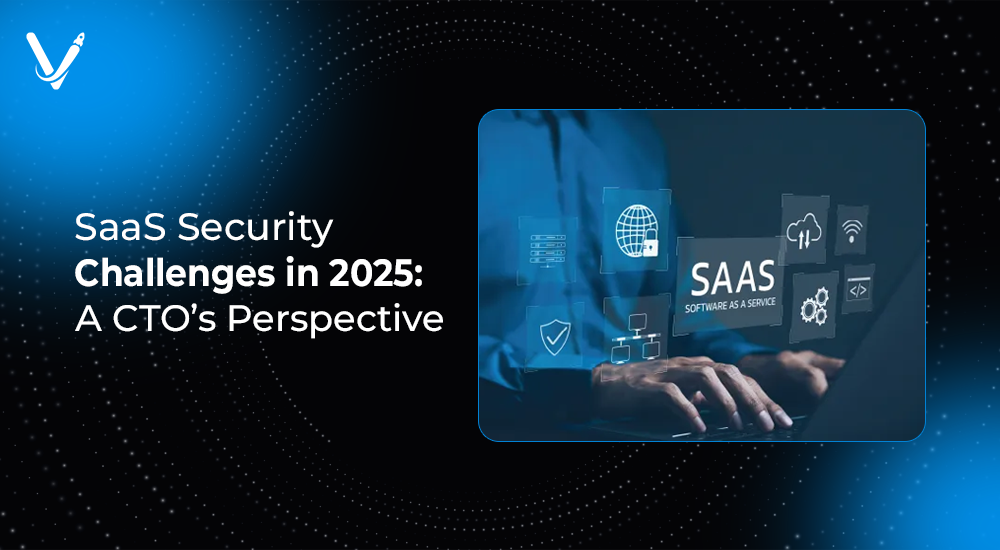SaaS Security Challenges in 2025: A CTO’s Perspective


- May 26, 2025



The digital revolution shows no signs of slowing down in 2025, and Software-as-a-Service (SaaS) remains at the forefront of enterprise transformation. As organizations lean heavily into cloud-based models, they reap the rewards of scalability, cost efficiency, and speed. However, this progress introduces an urgent and evolving concern: SaaS Security.
Today’s CTOs are more than just technology leaders. They are guardians of trust, responsible for protecting users, data, and brand integrity. As SaaS environments become more complex and interconnected, the risks grow just as rapidly. This article dives deep into the modern SaaS security landscape—its threats, responsibilities, strategies, and future. It’s tailored for CTOs, tech leaders, and security-conscious SaaS builders who want to stay ahead of the curve.
Let’s explore what it means to secure a SaaS platform in 2025, and how you can transform security into your competitive edge.
A SaaS environment refers to the cloud infrastructure, software stack, user interfaces, and data workflows that collectively power a SaaS application. Hosted by third-party providers and accessed via the internet, this model removes the need for customers to install or maintain software locally.
Key characteristics of a SaaS environment include:
Multi-tenancy: Multiple customers (tenants) share the same software and infrastructure.
Elastic scalability: Resources expand or shrink based on demand.
API integrations: SaaS apps often interact with other tools via open APIs.
Constant updates: Features and patches are deployed frequently with CI/CD pipelines.
Anywhere access: Accessible on any device with internet connectivity.
Understanding this environment is critical because its openness and interconnectedness are double-edged swords—enhancing usability while increasing attack surfaces.
SaaS security threats in 2025 are no longer just about preventing unauthorized logins. The rise of AI-driven attacks, supply chain compromises, and data sovereignty complexities has broadened the scope of concerns.
Modern threat actors are leveraging AI to mimic user behavior, bypass anomaly detection, and automate reconnaissance. For instance, in early 2025, a major payroll SaaS provider faced an AI-powered phishing campaign that used language models to simulate internal HR communications. The breach resulted in stolen credentials and leaked PII for over 300,000 users.
Proactive countermeasures:
Most SaaS applications rely on external SDKs, APIs, and cloud services. One weak link can compromise the entire stack.
Case in point: In 2024, a popular customer support SaaS platform was compromised due to a vulnerability in a third-party analytics library. The exploit was undetected for six weeks, exposing sensitive customer chats and credentials.
Recommendations:
Human error continues to be the root cause of many breaches. Unsecured S3 buckets, overexposed APIs, or forgotten test environments open unexpected doors to attackers.
The rise of shadow SaaS—unauthorized tools and services used by employees—compounds this risk. Without visibility, security teams can’t manage threats.
Solutions:
IAM is the foundation of SaaS application security. But in 2025, basic user/password combos aren’t enough. With hybrid work and bring-your-own-device (BYOD) trends, secure identity access is more challenging—and more essential—than ever.
Modern SaaS applications must treat IAM as a first-class citizen in their architecture, not an afterthought.
Every SaaS platform is a data goldmine—financial records, customer information, healthcare data, or even trade secrets. Protecting this data is not just a technical concern; it’s a legal and reputational imperative.
Use Data Loss Prevention (DLP) policies, database activity monitoring, and tokenization for compliance and protection. Integrate these tools into your SaaS security platform to enforce privacy by design.
Speed is the essence of SaaS, but rushing deployments without security checks is a recipe for disaster. In 2025, integrating security directly into DevOps pipelines (DevSecOps) is no longer optional—it’s the standard.
Adopting DevSecOps reduces time-to-fix, lowers vulnerabilities in production, and increases developer accountability.
Managing security across your SaaS stack manually is unsustainable. Instead, CTOs are investing in SaaS security platforms that offer unified visibility and automated controls.
AI is a double-edged sword in SaaS security.
To stay ahead, CTOs must embrace AI not only as a defense mechanism but also anticipate how attackers will exploit it.
Technology alone won’t protect a SaaS application. It takes people, processes, and mindset.
Security is everyone’s job—when developers, product managers, and even marketers understand risks, breaches become far less likely.
In 2025, customers want proof. Simply claiming “we take security seriously” is not enough. You need the badges and audits to show it.
Stay updated on global laws such as India’s Digital Personal Data Protection Act or proposed U.S. national cybersecurity frameworks.
Looking ahead, CTOs will face:
Investing now in resilience, automation, and education ensures your SaaS platform not only survives but thrives.
The road ahead for SaaS security is both thrilling and fraught with complexity. With threats evolving, regulations tightening, and technologies accelerating, today's CTOs must be both visionary leaders and diligent guardians.
By understanding the nuances of what a SaaS environment demands—multi-tenancy, speed, compliance, and user trust—you can build stronger foundations. Prioritize SaaS application security, adopt AI-backed defenses, automate your compliance, and above all, create a culture of accountability.
At Vasundhara Infotech, we help SaaS businesses strengthen their digital fortresses. Whether you’re scaling a new app or securing a mature SaaS platform, our experts ensure your users remain protected—confidently and continuously.
Ready to secure your SaaS future? Contact Vasundhara Infotech today to book your free consultation.
Copyright © 2025 Vasundhara Infotech. All Rights Reserved.